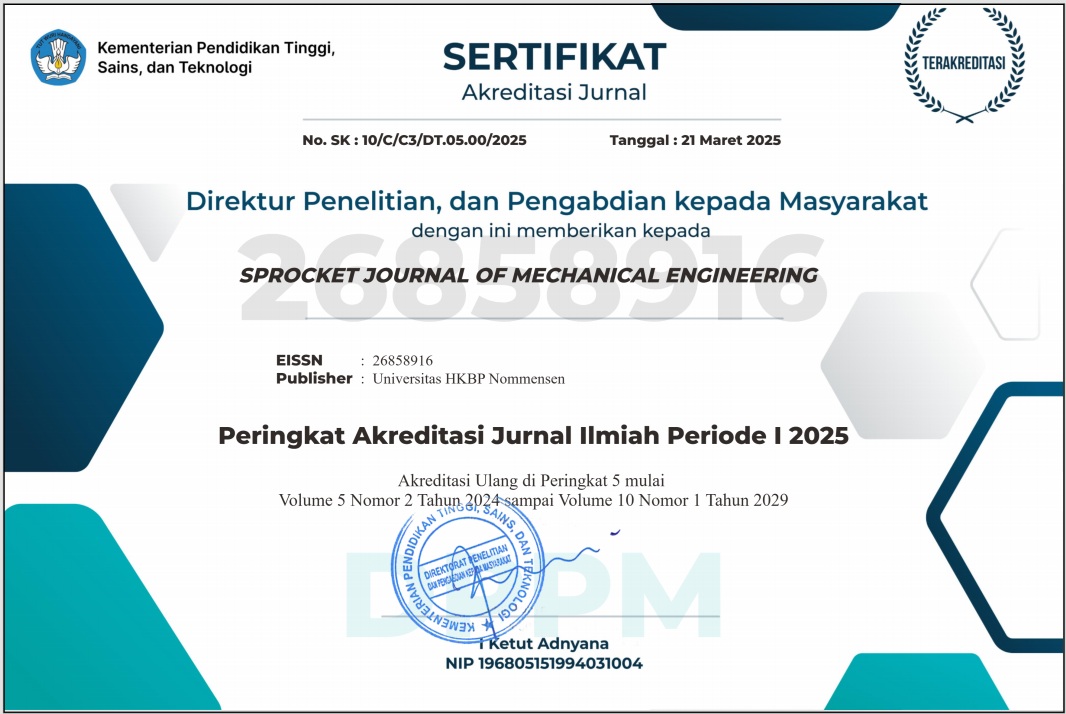ANALISIS TEKNO EKONOMI ATAP SURYA STUDI KASUS DI KOTA MEDAN, INDONESIA
Abstract
Indonesia has released its pledge on reducing Greenhouse Gas (GHG) emissions. Mitigation measures include increasing the use of renewable energy. Solar roofs are one potential mitigation measure to meet GHG emission reduction and renewable energy targets. As more attention is being focused on developing this renewable energy resource globally, the technical and economic assessment of this resource is critical to ascertain its feasibility. In this study, a technological and economic analysis of solar roof tops is presented. The analysis was carried out based on solar irradiation in the city of Medan, Indonesia. Solar irradiation over several days was measured. The measured data and the solar photovoltaic module panels available in the Indonesian market are used to carry out the technical analysis. Based on the technical analysis and economic analysis carried out, the economic analysis of the results of the visualization of the power produced by the PV system which was carried out for 1 year resulted in a total value of electricity of IDR 3,672,895 for the city of Medan. It is expected to provide the necessary information to build cities with low emissions.
Keywords: Solar Roof, Photovoltaics, Technoeconomics
References
[2] Li.Chong, Z.Dequn, Z.Yuan.2018. Techno-economic comparative study of grid-connected PV power systems in five climate zones, China. Energy S0360-5442,32052-8.
[3] A. Ihsan, S. GM, U. Tania.2018. Renewable and Sustainable Energy Reviews 83,18-32.
[4] K. N. Manoj, K. Sudhakar, S. Mahendran.2017. International Journal of Ambient Energy, 2162-8246.
[5] S. Piyush, B. Haranath, Y. Pradeep.2016. International Confrence on Power Systems 16358708.ISBN:978-1-5090-0128-6.
[6] S. Nemanja, K. Vladimir, M. Dragan, D. Boris, K. Nenad.2017. International Symposium POWER ELECTRONICS,19-21.
[7] G. Yousef, A. Mohammed.2017. International Mechanical Engineering Congress and Exposition IMECE2017,Vol.6. ISBN: 978-0-7918-5841-7.
[8] I. Imad and H. Fadia. 2019. International Journal of Energy Economics and Policy, 9(3),291-300.
[9] A. Mehebub.2017. International Journal of Advanced Research in Computer Science and Software Engineering.Vol.7. ISSN: 2277 128X
[10] U. Kotub, G. Rebecca , R. Jonathan, M. James, J. Paul.2017.Applied Energy 206,12-21.
[11] L. Amin, S. Peter, L. Jochen.2017. Energy Procedia 105. 4312 – 4320
[12] Adaramola MS, Paul SS, Oyedepo SO. Assessment of electricity generation and energy cost of wind energy conversion systems in north-central Nigeria. Energy Convers Manage 2011;52:3363–8.
[13] Hearps P, McConell D. Renewable energy technology cost review. Technical Paper Series. Melbourne Energy Institute; March 2011.
[14] Adaramola. M.S.2015. Energy Conversion and Management 101, 85-93.

This work is licensed under a Creative Commons Attribution 4.0 International License.
Penulis yang menerbitkan dengan SPROCKET JOURNAL OF MECHANICAL ENGINEERING menyetujui ketentuan berikut :
- Penulis memegang hak cipta dan memberikan jurnal hak penerbitan pertama dengan karya yang dilisensikan secara bersamaan di bawah Lisensi Internasional Creative Commons Atribusi 4.0 . yang memungkinkan orang lain untuk berbagi karya tersebut dengan pengakuan atas kepengarangan karya dan penerbitan awal dalam jurnal ini.
- Penulis dapat membuat pengaturan kontraktual tambahan yang terpisah untuk distribusi non-eksklusif atas versi jurnal yang diterbitkan dari suatu karya (misalnya, mempostingnya ke repositori institusional atau menerbitkannya dalam sebuah buku), dengan pengakuan atas penerbitan awalnya di jurnal ini.
- Penulis diizinkan dan didorong untuk mengunggah karya mereka secara daring (misalnya, di repositori institusi atau di situs web mereka) sebelum dan selama proses penyerahan, karena hal ini dapat mengarah pada pertukaran yang produktif, serta kutipan yang lebih awal dan lebih banyak dari karya yang diterbitkan (Lihat Pengaruh Akses Terbuka ).






.png)
.png)

